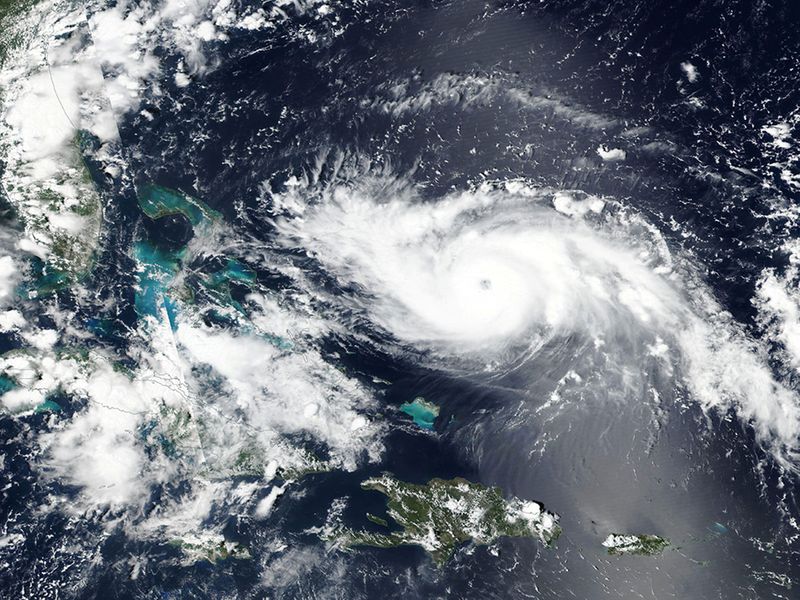
Hurricane Dorian has been described as the "strongest storm on the planet" based on modern storm records, with sustained wind speeds of 185 mph, possibly bringing a deadly "triple punch" — wind, rain and storm surge.
With gusts reaching more than 200 mph, and moving west at about 7 mph, Dorian has hit land in the Bahamas, and is en route to the eastern coast of Florda.
It has been described as "catastropic Category 5 storm".

Here's what we know so far and what to look out for in the next 24 hours:
What is a Category 5 hurricane?
A Category 5 Atlantic hurricane is one that is considered by the US National Hurricane Center (NHC) to have had sustained wind speeds greater than 136 knots (157 mph; 252 km/h or 70 m/s).
This category is a measure of a hurricane's power based of the Saffir–Simpson hurricane wind scale in the Atlantic Ocean north of the equator, the Caribbean Sea, and the Gulf of Mexico.
Hurricane Dorian falls under "super storm" category. It is now described as "strongest storm on the planet" based on modern storm records — with sustained wind speeds of 180 mph.
Hurricanes of such intensity occur once every three years in this region on average, and mostly in September.
It can bring substantial, destructive, life-threatening storm surge associated with the storm.
Only in six seasons — 1932, 1933, 1961, 2005, 2007, and 2017 — have more than one Category 5 hurricane formed. Only in 2005 have more than two Category 5 hurricanes formed, and only in 2007 and 2017 did more than one make landfall at Category 5 strength.
What are the areas like to be hammered by Dorian?
The US National Huricane Centre warned that sustained winds of 185 mph — may still grow more powerful as it hits Bahama Islands. The storm could also dump up to 30 inches of rains, leading to "life-threatening flash floods in northern portions of the Bahamas."
On Saturday, August 31, Dorian's projected path shifted east — increasing the likelihood that it will bring strong winds and dangerous storm surge along the coasts of Georgia, North Carolina and South Carolina.
Why is this hurricane called a "triple punch"?
Triple punch refers to wind, rain and storm surge. If the storm maintains its current ferocity and barrels into the Florida coast, experts predict the Category 5 storm could inflict severe damage to real estate, specially in Miami area.
As of late Sunday, the NHC said Florida may now avoid a direct hit. However, life-threatening storm surge and dangerous hurricane-force winds are still possible along portions of Florida's east coast through mid-week.
What's the value of real estate threatened by Dorian?
According to US TV channel CBS News, up to 668,000 Florida homes are at risk from Dorian. That's roughly valued at about $150 billion, the channel said, citing one analysis.
The CBS report states, however, that only about a third of threatened Floridians have flood insurance policies. Miami alone could sustain as much as $85 billion in property damage if it takes a hit from Dorian.
What is a storm surge?
A storm surge is a life-threatening inundation from rising water moving inland from the coastline, fanned by strong winds.
Where is the storm surge watch up?
Currently, part of Florida's Atlantic coast are now under a storm surge watch, according to the NHC. The watch runs from North of Deerfield Beach to the Volusia/Brevard County Line, the center said.
A watch means there is a possibility in the said locations over the next 48 hours.
Moreover, strong winds and dangerous storm surge watch are also up along the coasts of Georgia, North Carolina and South Carolina.
How the does of the 'eye' of Hurricane Dorian look like?
Inside the eye of a hurricane, there's what scientists call the "stadium effect". It happens at times in very strong hurricanes.
How is 'sustained wind speed' defined — and how are they measured?
The anemometer is a a device used for measuring wind speed. It was invented in 1846.
The NHC considers sustained wind speeds to be those that occur over a one-minute period at 10 metres (32.8 ft) above ground.
These wind speeds are estimated by using a blend of data from a variety of sources, which include observations from nearby ships, reconnaissance aircraft, or automatic weather stations and pictures from various satellites.
Which month do Category 5 hurricanes hit the most?
Thirty-five Category 5 hurricanes have been recorded in the Atlantic basin since 1851, when records began. Since 1851, the following Category 5 hurricanes were formed (by month):
- July: 1
- August: 8
- September: 19
- October: 6
- November: 1
There have been no officially recorded June or off-season Category 5 hurricanes.
The July and August Category 5 hurricanes reached their high intensities in the Gulf of Mexico and the Caribbean Sea.
September sees the most Category 5 hurricanes. This coincides with the climatological peak of the Atlantic hurricane season, which occurs in early September.
September Category 5s reached their strengths in the Gulf of Mexico, Caribbean Sea, and open Atlantic.
Based on previous records, these places are where September tropical cyclones are likely to form. Many of these hurricanes are either Cape Verde-type storms, which develop their strength by having a great deal of open water; or so-called Bahama busters, which intensify over the warm Loop Current in the Gulf of Mexico.
How many Category 5 hurricanes had been recorded?
Based on latest available official weather data, from 1924 to 2019, 35 Category 5 hurricanes have been recorded in the Atlantic basin. Hurricane records began in 1851, though their accuracy is suspect.
No Category 5 hurricanes were observed officially before 1924. It can be presumed that earlier storms reached Category 5 strength over open waters, but the strongest winds were not measured.
During major hurricane strikes before 1846, anemometers were often blown away, leaving the hurricane's peak intensity unrecorded.
For example, as the Great Beaufort Hurricane of 1879 struck North Carolina, the anemometer cups were blown away when indicating 138 mph (222 km/h).

When did Dorian make its first landfall?
Hurricane Dorian made a landfall on Elbow Cay in the Bahamas' Abacos Islands at 12:40 p.m. ET (8.40pm UAE time on Sunday), according to the US National Hurricane Center.
The storm is a Category 5 hurricane with 185 mph winds.
"This is a life-threatening situation. Residents there should take immediate shelter. Do not venture into the eye if it passes over your location," the center said in an advisory.
When was the decade that had the most Category 5 hurricanes?
Officially, the decade with the most Category 5 hurricanes is 2000–2009, with eight Category 5 hurricanes having occurred — Isabel (2003), Ivan (2004), Emily (2005), Katrina (2005), Rita (2005), Wilma (2005), Dean (2007), and Felix (2007).
The previous decades with the most Category 5 hurricanes were the 1930s and 1960s, with six occurring between 1930 and 1939 (before naming began).
Nine Atlantic hurricanes — Camille, Allen, Andrew, Isabel, Ivan, Dean, Felix, Irma and Maria — reached Category 5 intensity on more than one occasion. This meant that the reached Category 5 intensity, weakened to a Category 4 status or lower, and again escalating to a Category 5 hurricane.
However, weathermen said no Atlantic hurricane has reached Category 5 intensity more than three times during its lifespan. The 1932 Cuba hurricane holds the record for the most time spent as a Category 5 hurricane (although it took place before satellite or aircraft reconnaissance, so this record may be somewhat suspect).
Official records show Irma had the longest continuous span as a Category 5 storm in the satellite era.








